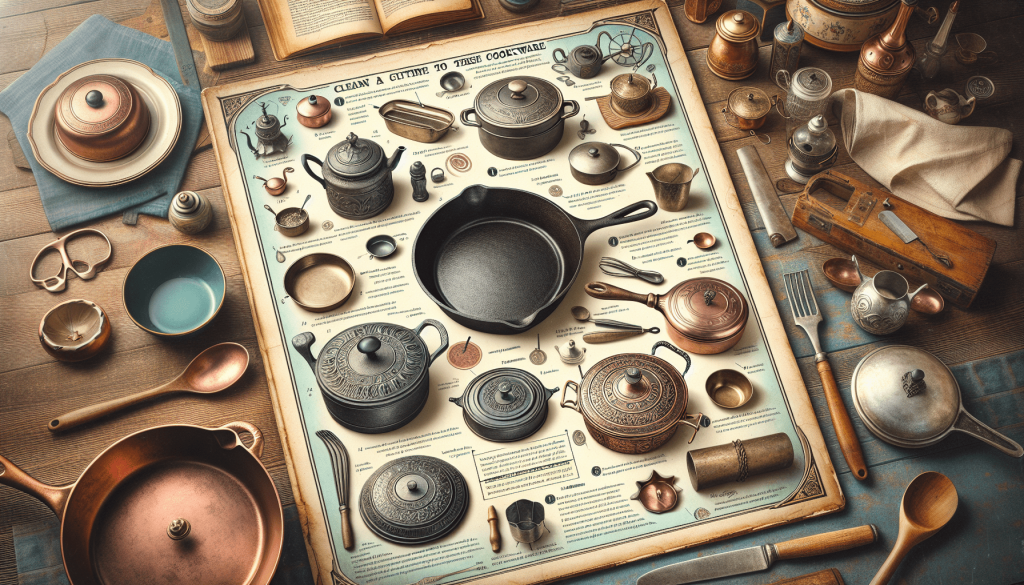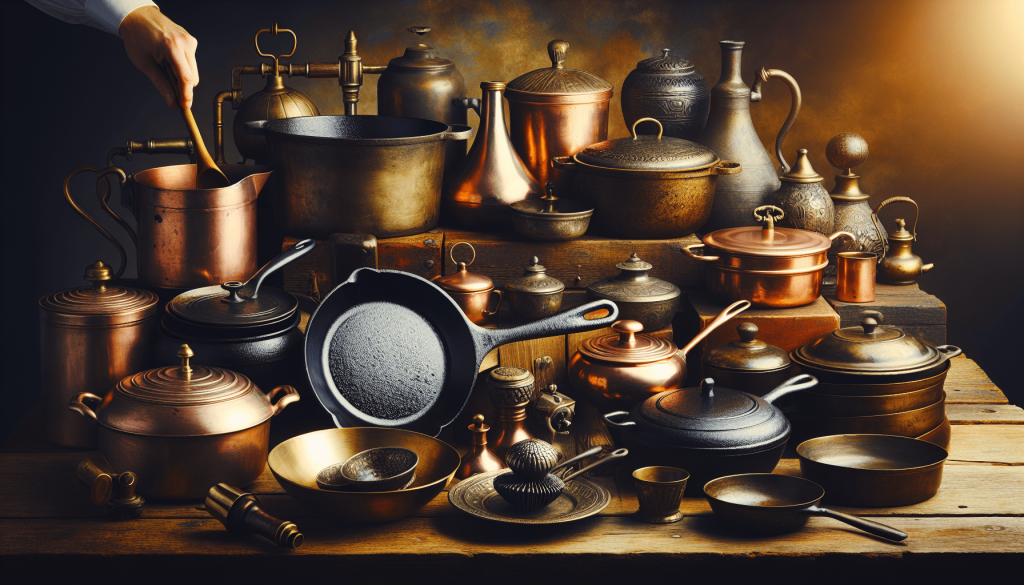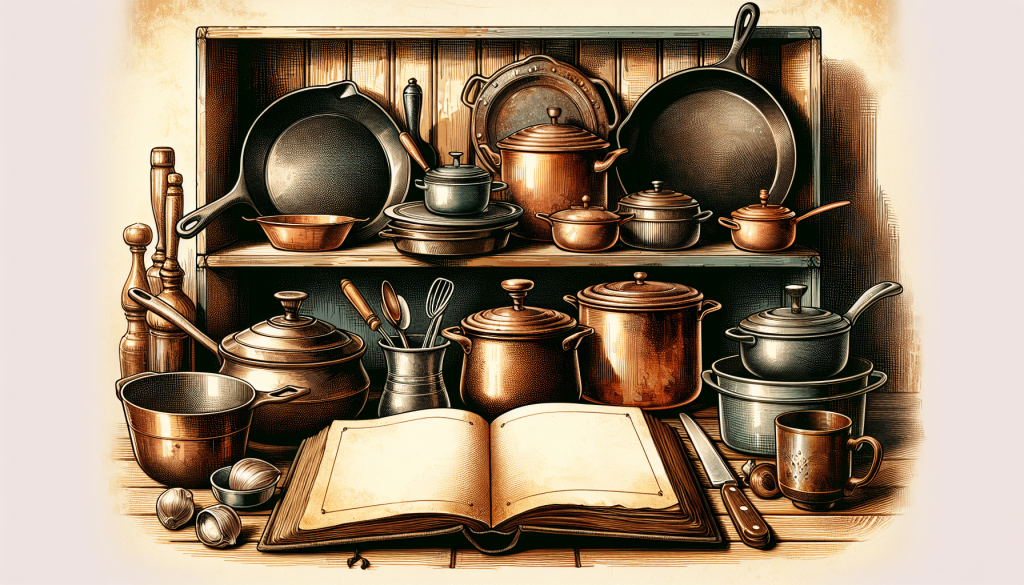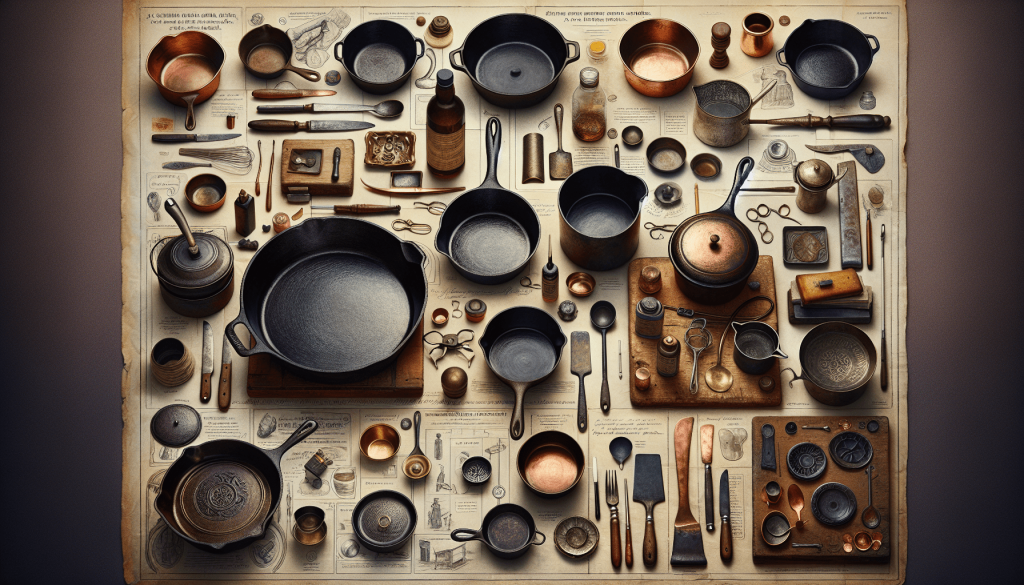In this article, you will discover some essential tips and tricks on how to care for your cherished vintage and antique cookware. Whether you have recently inherited these precious pieces or have been collecting them for years, it’s important to know the best practices to keep them in pristine condition. From cleaning techniques to storage solutions, we will guide you through the process, ensuring that your treasured cookware lasts for generations to come. Dive into the fascinating world of vintage and antique cookware care and unlock the secrets to preserving their beauty and functionality. Vintage and antique cookware can be a wonderful addition to any kitchen. These timeless pieces not only add a touch of nostalgia but also carry a sense of history and charm. However, caring for these treasured items requires special attention to ensure their longevity and maintain their beauty. In this comprehensive guide, we will take you through the step-by-step process of cleaning, removing stains, polishing, seasoning, storing, and preserving vintage and antique cookware. By following these tips, you can ensure that your cookware remains in excellent condition for years to come.

Cleaning Vintage and Antique Cookware
Identify the material of the cookware
The first step in cleaning vintage and antique cookware is to identify the material it is made of. Different materials require different cleaning methods to prevent damage. Common materials found in vintage and antique cookware include copper, aluminum, cast iron, stainless steel, and enamel. By identifying the material, you can choose the most suitable cleaning method.
Remove any food remnants
Before starting the cleaning process, it is essential to remove any food remnants from the cookware. Use a soft brush or sponge to gently scrub away any stuck-on food particles. Avoid using abrasive materials that could scratch or damage the surface.
Use mild dish soap and warm water
Once the food remnants have been removed, it’s time to clean the cookware. Fill a basin or sink with warm water and add a few drops of mild dish soap. Submerge the cookware in the soapy water and use a soft cloth or sponge to clean the surface. Be gentle, especially when dealing with delicate materials like enamel or copper.
Avoid abrasive cleaners
When cleaning vintage and antique cookware, it is crucial to avoid harsh or abrasive cleaners. These can strip away the patina or damage the surface. Stick to mild dish soap and warm water for regular cleaning. If you come across a stubborn stain, there are alternative methods to remove it without causing harm.
Do not soak the cookware for extended periods
While it may be tempting to soak dirty cookware for an extended period to loosen grime, this should be avoided. Prolonged soaking can cause damage to certain materials, especially if they have delicate or intricate designs. Instead, focus on gentle cleaning and removing any stains promptly.
Dry the cookware thoroughly
After cleaning the cookware, make sure to dry it thoroughly before storing or using it again. Use a clean, dry cloth to wipe away any excess moisture. Leaving the cookware damp can lead to rust or other damage, reducing its lifespan. If necessary, you can also air dry the cookware by placing it in a well-ventilated area.
Removing Stains and Discoloration
Create a paste with baking soda and water
For stubborn stains or discoloration on vintage and antique cookware, creating a paste with baking soda and water can be highly effective. Mix a small amount of baking soda with water until it forms a thick paste. The baking soda acts as a gentle abrasive that can help lift stains without damaging the material.
Apply the paste to the stained areas
Take a soft cloth or sponge, and using gentle circular motions, apply the baking soda paste to the stained areas of the cookware. Make sure to cover the entire stain with the paste and allow it to sit for a few minutes. The baking soda will work its magic, breaking down the stain and making it easier to remove.
Gently scrub the stains using a soft cloth or sponge
Using the same cloth or sponge, gently scrub the stained area with the baking soda paste. Be careful not to use excessive force or scrub too vigorously, as this can cause damage. Instead, apply a gentle and consistent pressure to lift the stain. If the stain is particularly stubborn, repeat the process until it fades or disappears.
Rinse the cookware thoroughly
Once you have successfully removed the stain, rinse the cookware thoroughly with warm water. Make sure all traces of the baking soda paste are removed, as leaving it on the surface can cause damage. If necessary, use a clean cloth or sponge to wipe away any residue.
Repeat the process if necessary
In some cases, stubborn stains may require multiple attempts to remove completely. If the stain persists after the first attempt, don’t be discouraged. Repeat the process as needed until the stain is fully lifted. Patience and persistence can often lead to successful stain removal.
Consider professional restoration for stubborn stains
If you have tried all the recommended methods and the stain still persists, it may be time to consider professional restoration. There are experts who specialize in restoring vintage and antique cookware. They have the knowledge and techniques to tackle even the most stubborn stains. Research reputable restoration services and consult them to determine the best course of action for your specific cookware.
Polishing Vintage and Antique Cookware
Choose a suitable polish for the material
Polishing vintage and antique cookware can help restore its natural shine and beauty. However, it is essential to choose a suitable polish for the specific material. Different metals require different polishes, and using the wrong one can result in damage. Consult with experts or do thorough research to identify the best polish for your cookware.
Apply a small amount of polish to a soft cloth
Once you have the appropriate polish, apply a small amount to a soft cloth. It is essential not to use too much polish, as it can leave a residue or even damage the surface. Start with a small amount and add more if necessary.
Gently rub the surface of the cookware
Using the cloth with the polish, gently rub the surface of the cookware in circular motions. Take care not to apply excessive pressure, as this can cause scratches or other damage. The goal is to restore the shine and remove any tarnish or dullness.
Buff the cookware to a shine
After applying the polish, use a clean part of the cloth to buff the cookware to a shine. Make sure to remove any excess polish and bring out the natural beauty of the material. This step can be repeated as needed until the desired level of shine is achieved.
Repeat the process as needed
Depending on the condition of the cookware, it may require multiple rounds of polishing to restore its full shine. If you are not satisfied with the initial results, repeat the process until you are happy with the outcome. Remember, patience and attention to detail are key when it comes to polishing vintage and antique cookware.
Avoid using polish on non-metal materials
While polishing is a great way to bring back the luster of metal cookware, it is important to avoid using polish on non-metal materials such as enamel or ceramic. These materials require a different cleaning and maintenance approach. Consult experts or do thorough research to determine the best way to care for these specific materials.
Seasoning Cast Iron Cookware
Clean the cast iron thoroughly
Cast iron cookware requires special care, including the process of seasoning to maintain its non-stick properties and prevent rust. Before seasoning, make sure the cast iron is thoroughly clean. Use mild dish soap, warm water, and a soft brush or sponge to remove any food remnants or debris.
Apply a thin layer of vegetable oil or shortening
Once the cast iron is clean, it’s time to season it. Apply a thin layer of vegetable oil or shortening to the entire surface of the cookware. Make sure to cover both the inside and outside, as well as any handles or knobs.
Spread the oil evenly on the surface, inside and out
Using a clean cloth or paper towel, spread the oil evenly on the surface of the cast iron cookware. Make sure to reach all corners and crevices to create a protective layer against rust and enhance the non-stick properties.
Preheat the oven to a moderate temperature
Preheat your oven to a moderate temperature of around 325°F (163°C). The heat will help the oil or shortening penetrate the cast iron and form a durable seasoning layer.
Place the cast iron upside down on a baking sheet
To prevent any excess oil from pooling, place the cast iron upside down on a baking sheet or oven-safe dish. This allows any droplets to drip away, promoting an even seasoning and preventing spots or pooling.
Bake the cookware for a specific duration
Place the baking sheet with the cast iron in the preheated oven and let it bake for a specific duration. Depending on the condition of the cast iron, this can range from 1 to 2 hours. The heat will help the oil polymerize and create a protective layer that enhances the cookware’s performance.
Allow the cookware to cool before removing
After the designated baking time, turn off the oven and allow the cast iron cookware to cool inside. Removing it too soon can cause damage or disrupt the seasoning process. Once fully cooled, remove the cookware and gently wipe away any excess oil.

Storing Vintage and Antique Cookware
Ensure the cookware is completely dry before storing
Before storing vintage and antique cookware, it is crucial to ensure that it is completely dry. Moisture can lead to rust or other forms of damage over time. Take extra care to dry all surfaces, especially for materials that are prone to retaining moisture, such as cast iron or copper.
Consider using individual protective covers or bags
To further protect your vintage and antique cookware, consider using individual protective covers or bags. These can help prevent dust, dirt, and scratches during storage. Choose covers made of breathable materials to avoid trapping moisture.
Use dividers or padding to prevent scratches
If you are storing multiple pieces of cookware together, use dividers or padding to prevent them from scratching each other. This is particularly important for delicate materials like enamel or ceramic. You can use soft cloth or felt dividers or even stack cookware with layers of protective cloth between them.
Store cookware in a dry and well-ventilated area
When it comes to storing vintage and antique cookware, it is essential to choose a dry and well-ventilated area. Moisture and humidity can cause damage, especially to materials like cast iron or copper. Avoid storing cookware in damp basements, garages, or areas prone to temperature fluctuations.
Avoid stacking heavy items on top
To prevent any unnecessary pressure or potential damage, avoid stacking heavy items on top of vintage and antique cookware. This can lead to dents, scratches, or even breakage. If space is limited, consider alternative storage options or rearrange your kitchen to accommodate the cookware properly.
Check the cookware periodically for any signs of damage
Even when carefully stored, it is important to check your vintage and antique cookware periodically for any signs of damage or deterioration. Inspect for rust, corrosion, cracks, or any other forms of wear. Catching any issues early on can help prevent further damage and allow for timely repair.
Avoiding Common Mistakes
Do not use harsh cleaning chemicals
When cleaning vintage and antique cookware, it is crucial to avoid using harsh cleaning chemicals. These can strip away the natural patina, damage the material, or even leave toxic residues. Stick to mild dish soap, baking soda, or specific cleaners recommended for the material.
Avoid using metal utensils on delicate surfaces
Using metal utensils on delicate surfaces such as enamel or ceramic can cause scratches or chips. Opt for wooden, silicone, or plastic utensils to avoid any potential damage. It’s better to be safe than sorry.
Do not use the dishwasher unless specifically mentioned as dishwasher-safe
While modern cookware can often be dishwasher-safe, it is generally best to avoid using the dishwasher for vintage and antique cookware. Harsh detergents and high temperatures can compromise the integrity of the materials or fade any decorative elements. Always refer to the manufacturer’s instructions or consult experts for guidance.
Do not expose delicate cookware to extreme temperature changes
Delicate vintage and antique cookware, especially materials like glass or ceramic, should not be exposed to extreme temperature changes. Sudden shifts from hot to cold or vice versa can cause cracking or shattering. Allow the cookware to cool gradually or warm up slowly before exposing it to different temperatures.
Avoid storing cookware in humid or damp areas
Humidity and dampness can be detrimental to vintage and antique cookware. Avoid storing cookware in areas with high humidity or prone to moisture, such as basements or damp cabinets. If necessary, use moisture-absorbing materials like silica gel packs to help maintain a dry environment.
Do not use vintage cookware if there are signs of damage or deterioration
If you notice any signs of damage or deterioration on your vintage or antique cookware, it is best to refrain from using it. Continued use can worsen the condition and potentially cause harm. Instead, consult experts or restoration professionals to assess the damage and determine the best course of action.

Preserving the Original Patina
Do not remove the natural patina unless necessary
The natural patina on vintage and antique cookware adds character and value to these pieces. In most cases, it is best to preserve the original patina rather than attempting to remove it. The patina tells a story and showcases the age and history of the cookware.
The patina adds character and value to vintage cookware
The patina on vintage cookware develops over time as a result of use and exposure to various elements. It adds a unique character and enhances the value of the cookware. Embrace the patina as an integral part of the piece’s history and beauty.
Regularly clean and polish the cookware to maintain the patina
While preserving the patina is important, it is also crucial to maintain the overall cleanliness and appearance of the cookware. Regular cleaning and polishing can help preserve the patina while still keeping the cookware in excellent condition.
Consult professionals for advice on preserving patina
If you are unsure about preserving the patina or have specific concerns about the condition of your vintage cookware, it is advisable to consult professionals. Experts in vintage and antique cookware can provide valuable advice and guidance on preserving the original patina and ensuring the longevity of your treasured pieces.
Seeking Professional Advice and Restoration
Consult experts in antique cookware for guidance
When it comes to vintage and antique cookware, there is a wealth of knowledge and expertise available from experts in the field. If you have any questions or concerns, don’t hesitate to reach out to these professionals. They can provide valuable advice on caring for your unique cookware collection.
Professional restoration may be required for severely damaged items
For severely damaged vintage and antique cookware, professional restoration may be necessary. Restoration experts have the skills and techniques required to repair, recondition, or enhance these items. They can help breathe new life into damaged pieces while preserving their historical and sentimental value.
Research reputable restoration services
When considering professional restoration for your vintage or antique cookware, it is crucial to research reputable restoration services. Look for specialists with experience in working with cookware from the specific era or materials. Reading customer reviews, seeking recommendations, or consulting with experts can help guide you to the right restoration service.
Get multiple opinions and cost estimates before proceeding
Before proceeding with any restoration work, it is wise to get multiple opinions and cost estimates. Different experts or restoration services may have varying approaches or pricing structures. Taking the time to gather multiple perspectives will help you make an informed decision based on your specific needs and budget.
Consider the value and sentimental importance of the cookware
When deciding whether or not to pursue professional restoration, consider the value and sentimental importance of the cookware. For truly irreplaceable family heirlooms or highly valuable items, investing in professional restoration may be worthwhile. However, for items of lesser significance, it may be more cost-effective to explore alternative options or embrace the imperfections as part of the cookware’s story.

Using Vintage and Antique Cookware Safely
Ensure the cookware is appropriate for the intended use
One of the most important aspects of using vintage and antique cookware safely is ensuring that it is appropriate for the intended use. Some cookware might not be suitable for modern cooking methods or certain types of foods. Research the specific cookware’s limitations and use it accordingly.
Check for any safety hazards such as loose handles or cracks
Before using vintage or antique cookware, always check for any safety hazards such as loose handles, cracks, or other forms of damage. Using damaged cookware can be dangerous and lead to accidents or injuries. If you notice any issues, consult experts or restoration professionals for advice on repair or replacement.
Do not use cookware with potential lead content
Some vintage and antique cookware, particularly older enamel or ceramic pieces, may contain lead. It is important to be cautious when using such cookware, as lead can leach into food and pose health risks. If you suspect the presence of lead, consult experts or avoid using the cookware for food preparation.
Avoid cooking acidic or reactive foods in certain materials
Certain vintage and antique cookware materials, such as copper or aluminum, may react with acidic or alkaline foods. This can result in off-flavors or even release harmful substances into the food. Use these materials for non-reactive cooking processes and opt for stainless steel or enamel-lined alternatives when working with acidic ingredients.
Follow proper handling and cooking instructions
Each vintage and antique cookware piece may have specific handling and cooking instructions. Whether it’s cast iron, copper, or enamel, familiarize yourself with the proper techniques and best practices. This will ensure optimal performance, longevity, and safety when using your treasured cookware.
If unsure, consult a professional before using the cookware
If you are unsure about the safe use of your vintage or antique cookware, it is always best to consult a professional. Experts in vintage cookware can provide valuable insights and guidelines specific to your cookware’s make, model, and era. Don’t take any chances when it comes to your safety and the well-being of your loved ones.
Appreciating the History and Value
Research the background and origin of the cookware
Vintage and antique cookware offers a fascinating glimpse into the past, and researching the background and origin of your pieces can deepen your appreciation. Look for markings, logos, or manufacturers’ information to uncover the story behind each item. Learning about the historical context and craftsmanship can enhance your enjoyment of using and caring for the cookware.
Learn about the historical significance and craftsmanship
Take the time to learn about the historical significance and craftsmanship of your vintage and antique cookware. Understanding the techniques, materials, and cultural context can provide a deeper connection to these pieces. It also helps in recognizing unique features, identifying potential replicas or reproductions, and appreciating the value of your collection.
Understand the value and collectability of the cookware
Vintage and antique cookware can hold significant value and collectability, both in monetary and sentimental terms. By educating yourself about the value and rarity of certain pieces, you can make informed decisions regarding their care and storage. It also allows you to make educated purchases when expanding your collection or seeking specific items.
Join communities or forums to share knowledge and experiences
Engaging with like-minded individuals who share your passion for vintage and antique cookware can be both enjoyable and educational. Join communities or online forums dedicated to cookware collecting, restoration, or cooking with vintage pieces. Sharing knowledge, experiences, and stories can deepen your love for these unique items and open up new avenues for discovering rare finds.
Preserve and pass down the cookware as a family heirloom
As custodian of vintage and antique cookware, one of the most meaningful ways to appreciate its history and value is by preserving and passing it down as a family heirloom. Share the stories and memories associated with the cookware with younger generations, and inspire them to carry on the legacy. By ensuring proper care and storage, you can enjoy the cookware for generations to come.
Caring for vintage and antique cookware requires patience, knowledge, and a tender touch. By following the steps outlined in this comprehensive guide, you can ensure that your cherished pieces remain beautiful, functional, and enjoyed for many more years. Whether you’re an avid collector or have inherited precious family heirlooms, the care you invest in these cookware treasures will be rewarded with their lasting beauty and the satisfaction of being part of their continued story.
